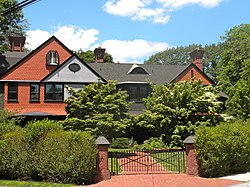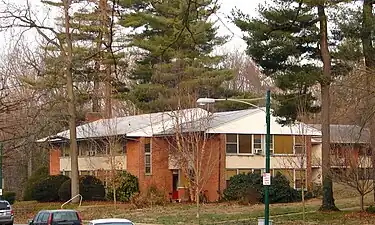Chestnut Hill Historic District | |
 Houston-Sauveur House (1885), 8205 Seminole Avenue. | |
   | |
| Location | Roughly bounded by Fairmount Park and Montgomery Co. Line, Philadelphia, Pennsylvania |
|---|---|
| Coordinates | 40°4′18″N 75°12′47″W / 40.07167°N 75.21306°W |
| Area | 1,920 acres (780 ha) |
| Architect | Multiple |
| Architectural style | Mid 19th Century Revival, Early Republic, Late Victorian |
| NRHP reference No. | 85001334[1] |
| Added to NRHP | June 20, 1985 |
The Chestnut Hill Historic District is a historic area covering all the Chestnut Hill section of Philadelphia, Pennsylvania.[2]
It was added to the National Register of Historic Places as a historic district in 1985.
Contributing properties
The historic district comprises 1,987 contributing properties over 1,920 acres, including:
- The Anglecot (designed by Wilson Eyre)
- Druim Moir Historic District, includes Romanesque Revival mansion (1883–86), designed by G. W. & W. D. Hewitt
- Graver's Lane Station (1883), designed by Frank Furness
- John Story Jenks School (1922), designed by Irwin T. Catharine
- Thomas Mill Covered Bridge (across the Wissahickon Creek, the only traditional covered bridge in Philadelphia)
- Wissahickon Inn (now Chestnut Hill Academy) (1883–84), designed by G. W. & W. D. Hewitt
- Inglewood Cottage (1850), designed by Thomas Ustick Walter
- The former site of Boxly, the estate of Frederick Winslow Taylor, where Taylor often received the business-management pilgrims who came to meet the "Father of Scientific Management"
- Esherick House (1961), designed by Louis Kahn
- Vanna Venturi House (1962–64), designed by Robert Venturi
 Inglewood Cottage
Inglewood Cottage The Anglecot
The Anglecot Cherokee Village Apartments
Cherokee Village Apartments Sam Austin House
Sam Austin House St. Martins SEPTA station
St. Martins SEPTA station
See also
- Awbury Historic District
- Colonial Germantown Historic District
- RittenhouseTown Historic District
- Tulpehocken Station Historic District
Wikimedia Commons has media related to Chestnut Hill, Philadelphia, Pennsylvania.
References
- ↑ "National Register Information System". National Register of Historic Places. National Park Service. March 13, 2009.
- ↑ Moak, Jefferson M. (1985). "Chestnut Hill Historic District" (PDF). National Register of Historic Places Nomination Form. Pennsylvania Historical and Museum Commission. Retrieved January 5, 2014.
External links
- Chestnut Hill Historical Society
- National Register of Historic Places Inventory–Nomination Form
- Historic American Buildings Survey (HABS) No. PA-1700, "Houston–Sauveur House, 8205 Seminole Avenue, Philadelphia, Philadelphia County, PA", 2 photos, 1 photo caption page
This article is issued from Wikipedia. The text is licensed under Creative Commons - Attribution - Sharealike. Additional terms may apply for the media files.

